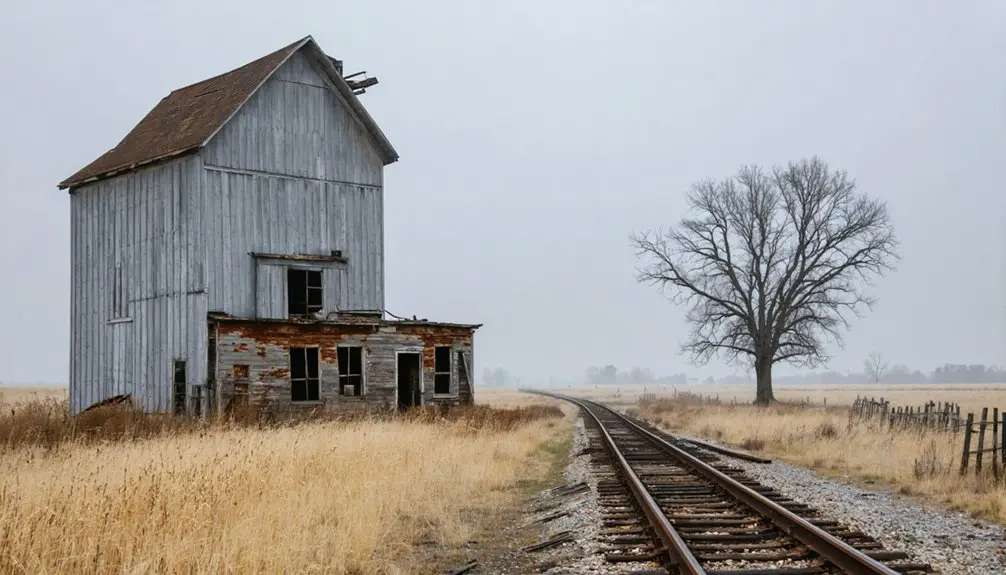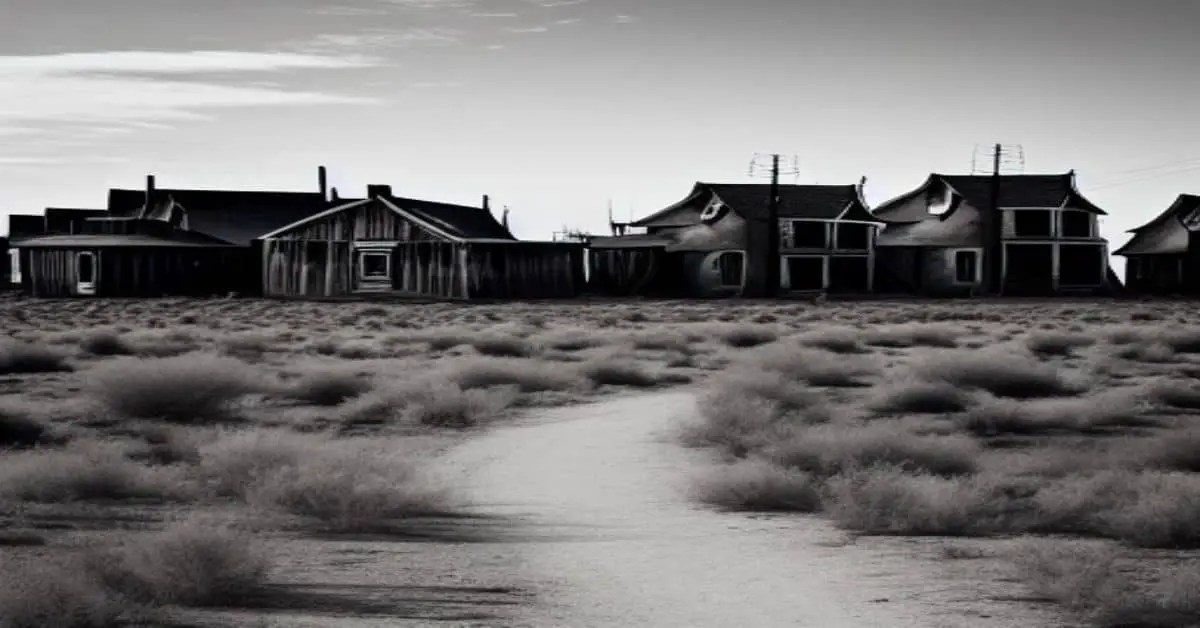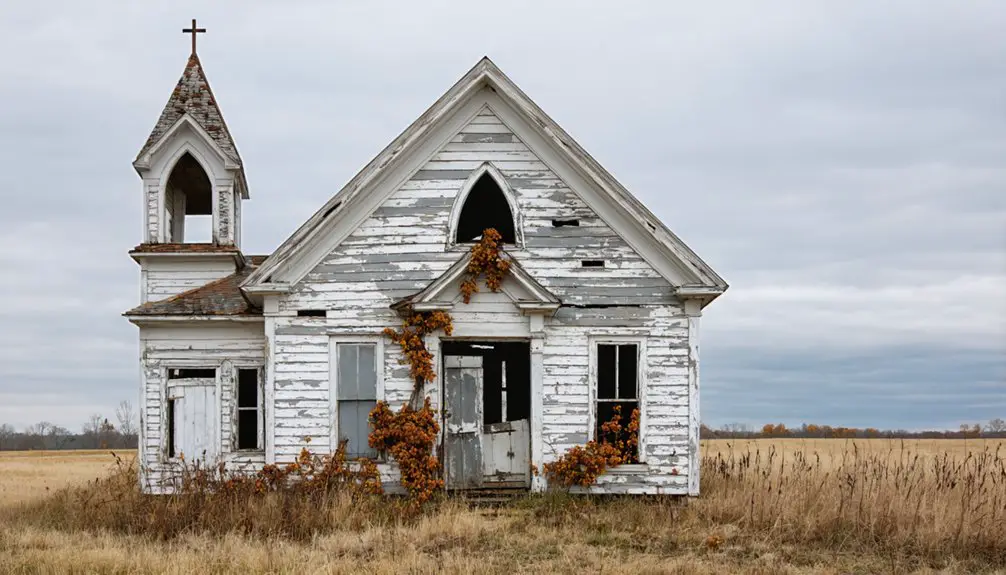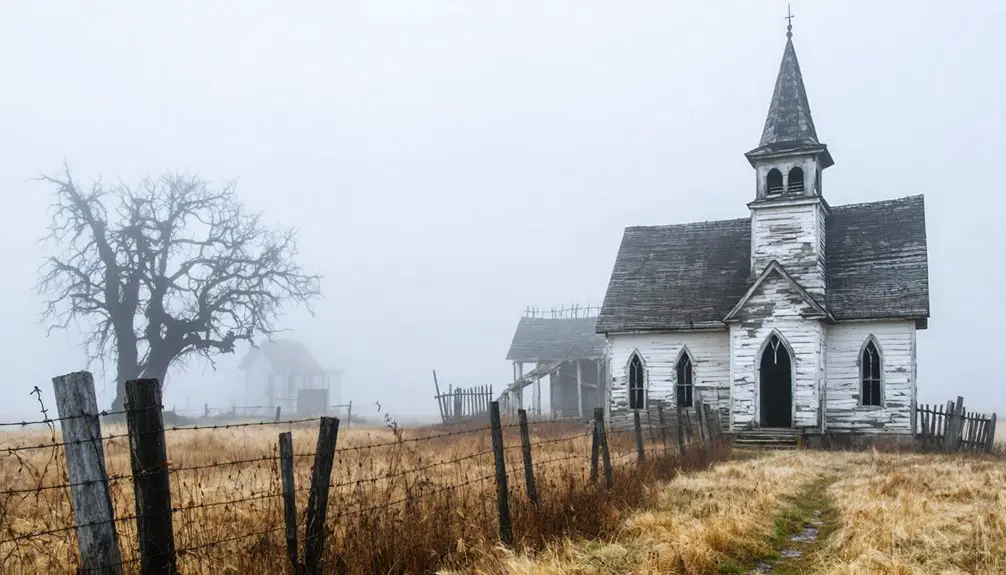You’ll find Holman’s ghost town remains 15 miles northeast of Springfield, Missouri, where it once flourished as a vibrant Route 66 community. Founded in 1903, the town centered around the prestigious Ranch Hotel, known for its stone pillars and Duncan Hines recognition. After the hotel’s devastating fire in 1961, Holman faced rapid decline. Today, you can spot remnants of the original settlement at what’s now Exotic Animal Paradise, where stone ruins tell tales of Missouri’s transportation evolution.
Key Takeaways
- Holman was founded in 1903 in Webster County, Missouri, and became a ghost town after its post office closed in 1911.
- The Ranch Hotel’s destruction by fire in 1961 marked a significant turning point in Holman’s decline toward ghost town status.
- Located along historic Route 66, Holman thrived with gas stations, motels, and cafes before transportation routes changed.
- Only ruins remain today, including a rock tenant house, gas station remnants, and a lake across Interstate 44.
- The site is now known as Exotic Animal Paradise, with historical markers indicating former locations of the Ranch Hotel complex.
The Birth of a Missouri Settlement (1903)
When Missouri’s Webster County saw the establishment of Holman in 1903, the small settlement emerged as a strategic point near the Greene County line, roughly 15 miles northeast of Springfield.
Named after the prominent Holman family, who were among the founding families, the town secured its place on Missouri Supplemental Route OO with the opening of a new post office that same year. Like other entries with the Holman surname, the settlement’s name reflected its founding family’s legacy.
The early infrastructure reflected the ambitious vision of its settlers, featuring a man-made lake as a development centerpiece. The lake’s location was notable for being positioned across I-44 from where the Ranch Hotel would later stand.
You’d have found a sturdy rock tenant house and a rock gas station leading to the Ranch Hotel, which became the town’s social hub.
While the settlement never incorporated as a formal municipality, these initial developments marked Holman’s hopeful beginnings as a rural Missouri community.
Life Along Historic Route 66
During the golden age of Route 66, Holman’s strategic location near this iconic highway brought new life to the rural settlement.
You’d find thriving businesses catering to both locals and travelers, with gas stations perched on hilltops and roadside cafes offering welcome respite from the journey.
The All-American Road designation in 2021 reinforces the historical significance of these former Route 66 communities like Holman.
The roadside culture that emerged transformed Holman and neighboring communities like Red Top into crucial service points along America’s most famous highway.
The economic impact was substantial – motels, diners, and fuel stops created jobs and connected these small Missouri towns to larger markets.
At its peak, Holman featured the Five Oaks Motel, Rainbow Court, and Oak Grove Lodge as prominent lodging establishments.
However, when modern interstate development redirected traffic away from the original Route 66 alignment, Holman’s prosperity began to fade.
The rise of interstate highways spelled doom for Route 66 towns like Holman, draining away the lifeblood of roadside commerce.
Today, while the town itself is gone, you’ll find remnants of this golden era through ruins and repurposed structures near the former settlement.
The Ranch Hotel’s Glory Days
Built in 1943 along U.S. Highway 66, the Ranch Hotel quickly became one of the region’s premier destinations.
You’d find this impressive property marked by two stone pillars at the entrance, leading to the main hotel building and five surrounding cabins. A 1948 expansion added a rear wing to accommodate the post-war travel boom. Much like United States Hotel in Stockton, a devastating fire would later threaten its existence.
The hotel’s grand ballroom hosted some of the area’s most memorable social gatherings, including an unforgettable New Year’s Eve celebration around 1959 when owners Nolan and Lois McDonald welcomed guests.
Duncan Hines even listed the establishment in his travel guides, cementing its reputation as a distinguished place to dine and lodge.
Beyond its role as a waypoint, the property featured a scenic lake and offered travelers a taste of Missouri hospitality at its finest. The location proved ideal for travelers as Route 66 had been strategically routed through Webster County in the late 1920s.
Notable Landmarks and Buildings
The rocky landscape of Holman featured several distinctive structures that defined this Route 66 community. Local stone shaped the town’s architectural character, with notable rock structures including a tenant housing unit and gas station positioned near the Ranch Hotel’s entrance. These buildings showcased the region’s natural materials through their rubble stone construction methods. The town suffered decline after I-44 bypassed Route 66 in the 1960s.
Native stone architecture defined Holman’s Route 66 legacy, with rustic buildings showcasing the region’s rugged character through local materials.
Much like the stone grocery store in nearby Avilla, these structures exemplified the area’s reliance on local building materials.
Across from the hotel site, you’ll find the lake and recreational area that’s existed since 1903, serving as one of the few remaining landmarks from Holman’s heyday.
While the Holman Schoolhouse once educated local children, and various rock structures dotted the landscape, these historic buildings have vanished.
Today, the former town site along Missouri Supplemental Route OO houses the Exotic Animal Paradise, marking a dramatic transformation from Holman’s early days.
A Community’s Gradual Decline
As you trace Holman’s decline, you’ll find its population steadily dwindled once Highway 66 lost prominence and local industries shuttered.
Infrastructure changes like the rerouting of major transportation routes often spelled doom for small towns across America.
The devastating Ranch Hotel fire in August 1961 marked a critical turning point, destroying one of the town’s most important gathering places and business centers.
Like Times Beach’s story of communal child-rearing, Holman was once a tight-knit community where neighbors looked after one another before economic hardship tore it apart.
This catastrophic loss, combined with the ongoing exodus of residents seeking better opportunities elsewhere, accelerated the community’s transformation into a ghost town.
Population Loss Timeline
Founded with optimism in 1903, Holman’s population trajectory followed a brief period of growth before entering a prolonged decline that would ultimately lead to its extinction.
You’ll find the first signs of population decline emerged as early as 1911 when the post office closed its doors. Throughout the following decades, community services gradually disappeared, including the Holman Schoolhouse, reflecting the town’s diminishing number of families.
The most dramatic shift came in 1961 when fire claimed the Ranch Hotel, a crucial hub of local activity. After this loss, remaining residents faced limited facilities – just a tenant house and gas station marked what was once a promising settlement.
Hotel Fire Impact
Within Holman’s steady decline, one catastrophic event in August 1961 marked a point of no return – the burning of the Ranch Hotel.
While the McDonald family was away on a weekend trip, the landmark structure burned completely to the ground, destroying a crucial piece of the community’s identity.
The economic impact rippled through Holman immediately. You’d have seen the loss of lodging for travelers, the elimination of hotel jobs, and decreased business at nearby establishments like the rock gas station.
But beyond finances, the fire dealt a crushing blow to community cohesion. The hotel had served as a central gathering place, hosting events like New Year’s Eve celebrations.
Without this anchor, social connections frayed and Holman’s sense of place diminished, accelerating its path toward ghost town status.
Present-Day Remnants and Legacy
If you visit Holman today, you’ll find the original town site transformed into Exotic Animal Paradise, with only a lake across Interstate 44 and a local road name preserving the settlement’s memory.
The once-bustling Ranch Hotel complex, which burned down in 1961, left behind ruins of a rock tenant house and gas station near its former entrance, though their current condition remains uncertain.
While few physical structures survive from Holman’s early days, the site’s connection to historic Route 66 and its evolution from frontier settlement to modern animal park illustrates the changing face of rural Missouri communities.
Physical Site Changes
Located along Missouri Supplemental Route OO about 15 miles northeast of Springfield, the former town of Holman has completely vanished from the physical landscape.
The site transformation has been dramatic – you’ll find no original buildings remaining, with the last significant structure, the Ranch Hotel, burning down in 1961. Today, Exotic Animal Paradise occupies the land where this once-thriving community stood.
Major geographical alterations include the construction of Interstate 44 and modern roadways that have reshaped the original town boundaries.
While the man-made lake created during Holman’s development still exists across I-44 from the old Ranch Hotel site, the town’s other landmarks – including the rock tenant house, gas station, schoolhouse, and post office – have all disappeared.
Only road names preserve Holman’s memory in the physical world.
Historic Tourism Opportunities
Despite Holman’s physical disappearance from the landscape, its location along historic Route 66 creates unique opportunities for heritage tourism.
You’ll discover cultural heritage through interpretive storytelling that brings the town’s memory alive, even without standing structures.
- Drive the original Route 66 corridor where Holman once thrived
- Visit the man-made lake that dates back to the town’s development
- Explore historical markers highlighting the former Ranch Hotel and gas station sites
- Connect with nearby Avilla’s complementary ghost town narrative
- Experience augmented reality recreations of lost buildings
The site’s integration into broader Missouri ghost town heritage trails offers a fascinating glimpse into early 20th-century settlement patterns.
Through educational programs and seasonal tours, you can immerse yourself in the story of this vanished Route 66 community.
Historical Significance in Webster County
While many Missouri ghost towns have faded into obscurity, Holman’s history illuminates Webster County’s early 20th-century development patterns along major transportation routes.
You’ll find Holman’s story reflects the broader trends of urban migration and transportation evolution that shaped the region’s destiny.
As one of several small settlements that emerged along U.S. Highway 66, Holman showcases how Webster County’s communities adapted to changing infrastructural needs.
The town’s rise and fall – from its 1903 founding to its transformation into the Exotic Animal Paradise – mirrors the economic shifts that impacted rural Missouri settlements.
Through its preserved records and GNIS designation, Holman continues to teach valuable lessons about the delicate balance between progress and preservation in America’s heartland.
Frequently Asked Questions
Were There Any Notable Crimes or Incidents Reported in Holman’s History?
Devious darkness holds few documented historical crimes in your search of Holman itself. You’ll find unsolved mysteries nearby, with surrounding areas reporting murders linked to the Holman name and regional Civil War violence.
What Native American Tribes Originally Inhabited the Holman Area?
You’ll find the Osage Tribe was the primary indigenous group in this region, though archaeological evidence shows Missouri tribes also lived there before European contact. Other tribes like Sac and Fox later passed through.
Did Any Famous People Ever Stay at the Ranch Hotel?
While the Ranch Hotel’s famous visitors aren’t documented in ranch history, you’ll find it was featured in Duncan Hines’ travel guide, though no celebrity stays were ever officially confirmed.
What Was the Average Property Value in Holman During Its Peak?
You can’t pinpoint exact property values since no records survive, but given the property market and swift economic decline, values likely ranged from $200-$1,500 per parcel in early 1900s dollars.
Were There Any Local Legends or Folklore Associated With Holman?
While you’ll find stories of ghost sightings and local hauntings in nearby Missouri areas, there aren’t any documented supernatural legends specific to Holman itself, though regional folklore themes likely influenced the area.
References
- https://sites.rootsweb.com/~motttp/history/ghost_towns/holman_mo.htm
- http://www.howellcountynews.com/history/howell-county-ghost-town-several-names
- https://www.legendsofamerica.com/avilla-missouri/
- https://en.wikipedia.org/wiki/Holman
- https://en.wikipedia.org/wiki/List_of_ghost_towns_in_Missouri
- https://en.wikipedia.org/wiki/History_of_Missouri
- https://www.josephsmithpapers.org/paper-summary/account-with-estate-of-oliver-granger-between-circa-3-february-and-circa-2-march-1842
- https://tile.loc.gov/storage-services/public/gdcmassbookdig/holmansinamerica02holm/holmansinamerica02holm.pdf
- https://www.ksmu.org/news/2025-04-23/springfield-named-host-city-for-national-route-66-hundred-year-anniversary-kickoff
- https://www.theroute-66.com/red-top.html



